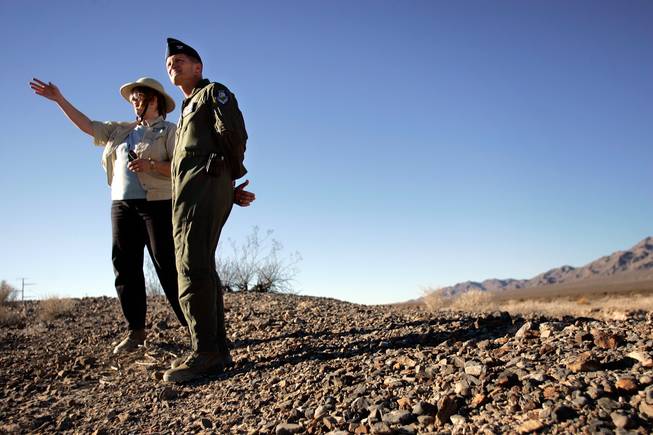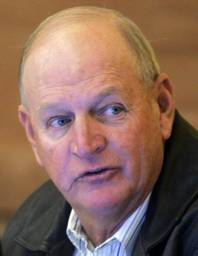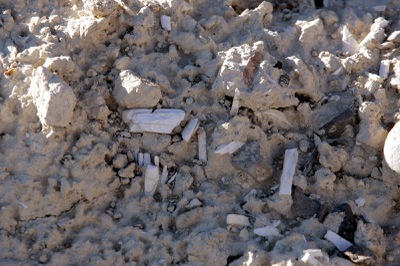
Jill DeStefano, founder of the Protectors of Tule Springs, tours the Upper Las Vegas Wash with Col. Dave Belote in 2008. The group wants to preserve the fossil beds in the northwest valley that may be designated a national monument. But NV Energy has its own plans for the site.
Friday, Aug. 6, 2010 | 2:01 a.m.
Related .pdf document
Sun archives
- NV Energy wants to build transmission line from Ely to Las Vegas (3-9-2009)
- NV Energy delays coal plant, hastens transmission line project (2-9-2009)
- Yackira remains bullish on utility's master plan (8-22-2008)
- Snell & Wilmer eager to challenge allegations (6-27-2008)
- Natural gas pains (5-30-2008)
- Renewable energy efforts gather momentum (1-4-2008)

Shari Buck

Tom Collins

Harry Reid
Power lines connecting Northern and Southern Nevada are needed as dozens of green energy plants are being planned or built from the Amargosa Valley to Carson City.
But there’s a problem. NV Energy says it must carve out a 260-foot swath for transmission lines that would outline an area so full of ice age fossils that it is likely to be designated a national monument.
That status would put the nearly 30,000 acres of desert in the north Las Vegas Valley, near Aliante Station, in the pantheon of national parks, giving it access to federal park funding. Supporters expect national monument legislation to be introduced in Congress soon and with the full support of Southern Nevada’s representatives.
Monument supporters say NV Energy’s transmission corridor would be “devastating” to the monument, where they envision a visitors center and designated areas where tourists and schoolchildren can do their own “digs” for still-buried fossils.
With new power poles outlining the northern border, and existing poles near the area’s southern edge, “you’d be surrounded by power poles, and the Park Service does not want to build parks whose viewscapes are surrounded by power poles,” said Jill DeStefano, a schoolteacher who founded Protectors of Tule Springs and began the push to preserve the massive fossil beds.
She added that a section of the new corridor farther east near Decatur Road intersects an area considered one of the richest in ice age fossils, “and you’d be tearing that up.”
For more than 40 years, archeologists have known about the Upper Las Vegas Wash’s treasure trove of fossils. In humidity and temperature-controlled cabinets in the San Bernardino County museum, scientists have preserved 9,876 fossils unearthed when 36 power poles were erected there.
As drawn on some maps, the 500-kilovolt power lines would follow an existing transmission corridor that juts east at Moccasin Road across U.S. 95. That corridor, which already features massive power poles, angles southeast around Decatur Road before heading directly east again on Grand Teton Drive.
The new lines would not angle southeast at Decatur, however. Instead they would keep going east on Moccasin along the northern edge of the monument. At Lamb Road, they would shoot south to Grand Teton Drive, join the existing transmission corridor, then go east.
Last week, DeStefano and North Las Vegas Mayor Shari Buck visited Washington, D.C., to meet with their congressional leaders, urging them not to include the power-line corridor, as is, in any legislation.
“We have a once-in-a-lifetime opportunity, and for it to be ruined by transmission lines is really unthinkable,” Buck said. “If it wouldn’t be done at Red Rock (Canyon National Conservation Area), why would it be done here?”
Jennifer Schuricht, NV Energy spokeswoman, said the transmission lines are “critical” for delivering solar energy, some of which will be generated in the Amargosa Valley to the northwest.
“The proposed lines also address future requirements for reliability and expansion of the electrical system in the northern part of the valley as well as the Apex industrial area,” she said.
Buck and DeStefano accuse NV Energy of trying to add wording to a national monument bill that would provide a utility right of way.
For more than a year, DeStefano and her Protectors of Tule Springs group lobbied for support from neighboring constituencies, including Clark County, North Las Vegas, Las Vegas, the U.S. Air Force and the Paiute Indian tribe. Armed with that support, which came in large part because local leaders recognize the potential economic and educational boon of a national monument, they lobbied for federal backing.
“This is devastating,” DeStefano said. “A year ago, we put together a whole coalition of people and invited NV Energy to the table. Now suddenly, just before legislation is going to be filed, they say they need this line and they want a right of way to do it.”
Schuricht said NV Energy learned about the national monument idea in “late 2009” and “shortly thereafter, NV Energy proactively contacted local municipalities and set up initial meetings with supporters of the monument.”
DeStefano had a one-word response to that statement: “Garbage.”
Commissioner Tom Collins, who previously worked for the power company as a journeyman lineman, said NV Energy has “not been forthright,” adding that company representatives visited him only last week to talk about it.
“We’ve known about this for more than a year and only now are they coming forward,” Collins said of NV Energy.
The County Commission last year unanimously approved Collins’ resolution supporting federal legislation to create a “fossil beds” national monument.
Commissioner Chris Giunchigliani said, “NV Energy should be putting out alternatives that are feasible besides this line, not just about what they want.”
U.S. Sen. Harry Reid, D-Nev., has expressed interest in the national monument. At the same time, he supports Nevada’s efforts to become a green-energy producer and exporter. He told the Sun Thursday he “is hopeful the parties will work together to find a solution that maximizes Nevada’s renewable energy potential, while also allowing for protection of fossil resources in the (Las Vegas) wash.”
Commissioner Larry Brown echoed that idea.
But Buck said North Las Vegas representatives had met with NV Energy, and their “conversations went nowhere.”
A July 19 letter to Reid, co-signed by Buck and Las Vegas Mayor Oscar Goodman, said that North Las Vegas and Las Vegas council members had several recent meetings with NV Energy, but the company “has not yet provided specific information that would support their proposal, and company representatives have not presented or discussed alternatives.”
Buck and DeStefano want NV Energy to consider a transmission corridor that takes the power lines south through Nye County. Collins said the company should consider pushing the lines farther south, then running them west to east along Interstate 215.
The North Las Vegas mayor added that she would participate in another meeting that included all parties.
One unusual fact — Clark County’s D.C. lobbyist, Marcus Faust, is also NV Energy’s — might actually help in working out a compromise.
Clark County Manager Virginia Valentine said Thursday she will talk to Faust about the potential for conflict because he works for both entities. However, she added, “the arrangement is acceptable if it appears that (he) can facilitate a compromise.”


Join the Discussion:
Check this out for a full explanation of our conversion to the LiveFyre commenting system and instructions on how to sign up for an account.
Full comments policy